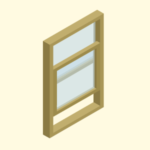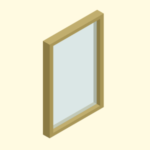Choosing new window styles? No problem! Here are some quick tips to make it easy.
Window manufacturers are good listeners. They’ve taken consumer feedback and created a wide range of window styles and options. The odds are in your favor that there are windows available that meet your needs. All types of windows—called operator types –can feature efficient technologies that lower your monthly utility bills but also have additional features and characteristics that affect efficiency. Here’s your five-minute guide to the main types:
 DOUBLE-HUNG WINDOWS
DOUBLE-HUNG WINDOWS
These are the most common window, with two panes of glass in frame units. Each one is called a sash. They slide up and down within the window frame, so you can open the top half or the bottom. They can be found in traditional types of homes like townhouses and farmhouses, as well as more modern ones like ramblers and bungalows. Their popularity makes pricing reasonable as window manufacturers compete on affordability.
 SINGLE-HUNG WINDOWS
SINGLE-HUNG WINDOWS
A simpler and less-expensive version of the double-hung, this option allows for only the bottom half of the window to slide up, with a fixed sash above it.
 SLIDING WINDOWS
SLIDING WINDOWS
As their name indicates, sliding windows have sashes that slide from side to side instead of up and down. This category of window includes sliding doors that provide a bright and spacious entryway to backyards and patios. Sliders were popular for builders in the 1950s and 1960s and are a good style for mid-century modern architecture. The mechanisms are simple, and that can lower costs, although occasional cleaning is required to keep the tracks free of the dust and debris that can settle in those spots. Sliders are also great if you open and close your windows frequently.
 CASEMENT WINDOWS
CASEMENT WINDOWS
This type of window opens by swinging out from the side, typically using a hand crank. These offer a slightly more modern look for houses using a newer architectural style and are almost as popular as double-hung windows. They are also more efficient, with fewer air leakages.
 AWNING WINDOWS
AWNING WINDOWS
Awning windows are like casement windows save for their hinges are on the top of the frame, and the window swings out from its bottom.
 FIXED WINDOWS
FIXED WINDOWS
Windows that don’t open and close are called fixed and come in several different sizes and configurations. Flat versions are common in apartment buildings. Bay windows combine multiple panes of glass together to extend outward from the walled surface of a house. They typically have a fixed center pane and angled panes on the side that may sometimes open. Bow windows are similar but arranged at smaller angles to provide a curved effect. These allow more sunlight to enter a house and expand views to the outdoors. They can also be more expensive and less efficient.
 SKYLIGHTS
SKYLIGHTS
Windows on ceilings provide additional natural light. They can be fixed or have a mechanism to open and close.
Whether you’re replacing all of the windows in your home or just one, it’s important to know its type when meeting with a window sales professional. You can find more information on energy-efficient windows in the Window Selection Tool.
